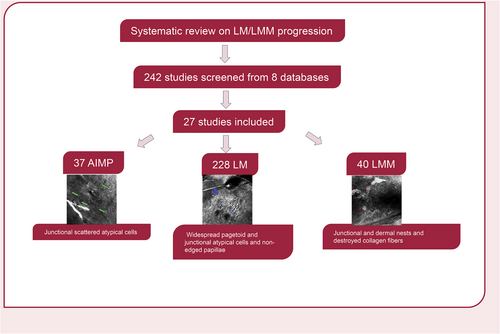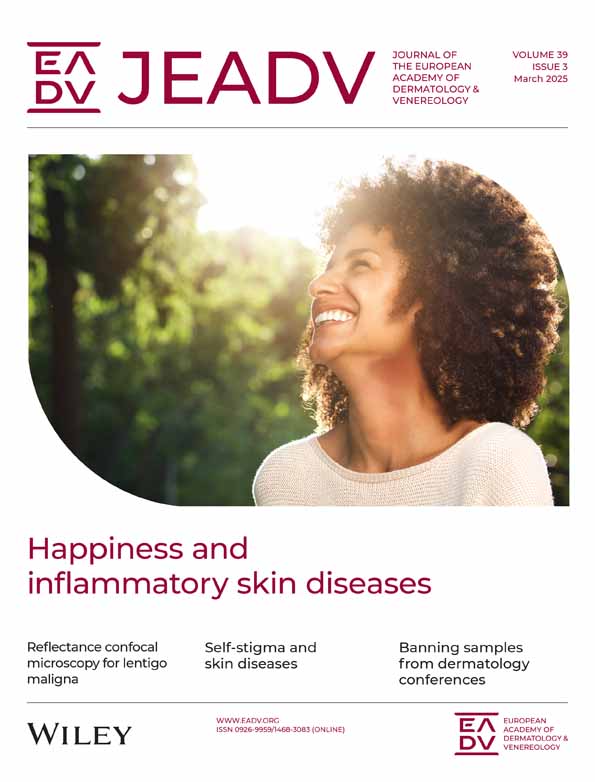In vivo reflectance confocal microscopy role for early to advanced lentigo maligna melanoma spectrum: A systematic review and pooled analysis
Registration: PROSPERO registration number 345241 (https://www.crd.york.ac.uk/PROSPEROFILES/345241_STRATEGY_20220708.pdf).
Abstract
Background
Lentigo maligna (LM) is a growing problem worldwide and the main type of melanoma in situ in some Caucasian populations. It presents as a spectrum from atypical intraepidermal melanocytic proliferation (AIMP) to invasive lentigo maligna melanoma (LMM). Accurate diagnosis and staging are crucial for determining appropriate management strategies.
Objectives
To assess the role of in vivo reflectance confocal microscopy (RCM) in differentiating early and advanced stages of lentigo maligna.
Methods
A systematic search was conducted on Medline, PubMed, Scopus, Web of Science, Proquest Central, Embase, Cochrane and Google Scholar. References of included and excluded studies were reviewed for additional sources. Studies involving RCM for AIMP, LM and LMM diagnosis published until 1 December 2023, were selected for analysis. Publications on other non-invasive imaging techniques, other skin diseases or those addressing only RCM surgical margins and therapeutic response without reporting RCM features were excluded. Each article was reviewed by two experts, with disagreements resolved by a third expert. Data for each RCM feature were pooled, and odds ratios (ORs) and 95% confidence intervals (CIs) were calculated. Features were stratified for architecture, cellular morphology and distribution.
Results
Twenty-seven articles involving 303 lesions were included. Features favouring LM over AIMP included (1) Architecture: the presence of non-edged papillae (OR 4.50, 95% CI 1.92–10.52) and (2) Cellular distribution: widespread pagetoid cells and junctional atypical cells (OR 25.06, 95% CI 4.19–148.45) and junctional nests (OR 18.06, 95% CI 3.04–106.32). Features favouring LMM over LM included (1) Architecture: epidermal disarray (OR 5.03, 95% CI 1.90–13.22), junctional disarray (OR 4.19, 95% CI 1.54–11.33) and destroyed collagen fibres (OR 3.91, 95% CI 1.80–8.44) and (2) cellular distribution: widespread pagetoid and junctional atypical cells (OR 2.71, 95% CI 1.27–5.75) and junctional nests (OR 4.48, 95% CI 2.12–9.43).
Conclusions
This study identifies the RCM features associated with the LM/LMM spectrum.
Graphical Abstract
Key confocal features in LM/LMM progression: Architecture: AIMP: Preserved; LM: Non-edged papillae; LMM: Epidermal/junctional disarray, collagen fibre destruction. Cellular distribution: AIMP: Junctional scattered atypical cells; LM: Widespread pagetoid and junctional atypical cells with junctional nests; LMM: Widespread pagetoid and junctional atypical cells with junctional and dermal nests. Cell Types: AIMP: Dendritic cells with mild atypia; LM/LMM: Dendritic cells with mild atypia, round nucleated cells with marked atypia.
CONFLICT OF INTEREST STATEMENT
RAS has received fees for professional services from Hoffmann-La Roche Ltd., Evaxion, Provectus Biopharmaceuticals Australia, Qbiotics, Novartis, Merck Sharp & Dohme, NeraCare, AMGEN Inc., Bristol-Myers Squibb, Myriad Genetics, GlaxoSmithKline. PG has received honoraria from Metaoptima and fees for professional services from L'Oreal. LKM has received speaking fees from Astra-Zeneca. RAS and AEC are supported by NHMRC Investigator Grants (#2018514 and #2008454). SL and PG are supported by Melanoma Institute Australia. GH was supported by the NHMRC CRE 1135285 and the Lady Mary Fairfax Foundation. BMG was supported by the Melanoma Institute Australia PhD scholarship and Australia Melanoma Research Foundation top-up grant. AKS is supported by an NHMRC Synergy grant (#2009923). LKM is supported by the Warwick L. Morison Professorship in Dermatology UNSW. BG was supported by the Lady Mary Fairfax Foundation/Melanoma Institute Australia Dermatology fellowship. PF, HC, CS and AG have no disclosures.
Open Research
DATA AVAILABILITY STATEMENT
The data that support the findings of this study are available from the corresponding author upon reasonable request.





